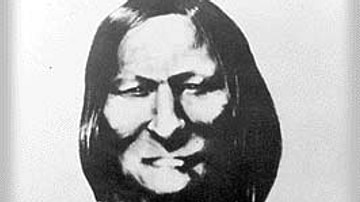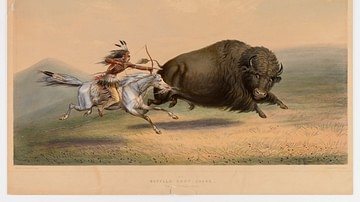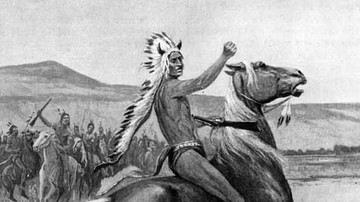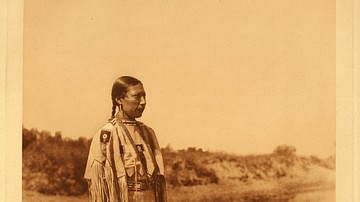The Woodpecker's Mother-in-Law is a Cheyenne tale which, like any other, is open to various interpretations but, among them, highlights the strength and autonomy of Cheyenne women. The old woman and her daughter each possess supernatural powers, which they wield in asserting their own desires. The men in the story can be seen as secondary characters.

At the same time, the five young males – Jack Rabbit, Buffalo, Mountain Lion, Bear, and Hairy Woodpecker – have their own story to tell, each with its own moral. All five are friends who wish to marry the pretty maiden, and, as each one is rejected by her, the others are discouraged from trying. Still, they persevere, and Woodpecker wins her hand, encouraging the cultural value of persistence in reaching a goal.
The five older men at the end of the story also have their own story in remaining faithful to the cause of Woodpecker and his new wife. As truthfulness is a Cheyenne cultural value, the men cannot lie, and so it must be assumed that Woodpecker asked them to be his lookouts without his bride present. When the old woman asks if they have seen her daughter, then, they can honestly reply, "No." The importance of faithfulness is emphasized in that four of them give their lives in service to the Woodpecker's cause.
The Girl & Her Suitors
The focus of the tale, however, is on the young woman and her mother – the woodpecker's mother-in-law – and the dynamic between them regarding the girl's courtship and marriage. At the time the story was composed, a young man would arrive at the lodge of a girl he was interested in and present her parents with gifts. If these were acceptable, a marriage agreement would be negotiated. In this story, the girl rejects all suitors, no matter how valuable their gifts. There is no mention of the old woman interfering with her choice in this. As is seen later in the story, the girl refuses these suitors because she is looking for a certain quality in a mate which none of them seem to possess.
As in all Native American tales, animals play an important role in The Woodpecker's Mother-in-Law and, as usual, each animal is chosen by the storyteller for the attribute they are most closely associated with. All five of these animals might appear in stories symbolizing a great variety of aspects of the human condition, but, for the Cheyenne, there are some that are recognized more often than others. The jackrabbit symbolizes fertility, the buffalo, abundance, the mountain lion, courage, and the bear, strength and personal power. The woodpecker, who the girl finally chooses, often symbolizes the value of friendship, listening, and paying close attention; this is the attribute the girl has been looking for in a mate. Fertility, abundance, courage, and strength would all be qualities her parents might value, but she, clearly, does not or, at least, not as highly as friendship.
Her choice in a mate, and so her future course in life, clashes with her mother's designs for her, which, though unstated, seem to include keeping her in the home as a helper with chores – such as chopping and gathering wood – and also as a source of wealth as it seems the young men of the village will keep bringing gifts in hopes of marrying the girl. Both women possess supernatural abilities but, in the end, the girl triumphs, using her own ability but, more importantly, trusting in Woodpecker's friends and family – her new community – not only in her own strength.
Birds & the Divine
Birds frequently appear in Cheyenne tales – and the stories of the many other Native peoples of North America – as messengers from the spirit world who serve the Creator. In the Cheyenne story, The Little Girl and the Ghost, for example, it is a small bird who saves the girl from being eaten, and in the Pawnee legends, The Boy Who Was Sacrificed and A Story of Faith, birds also play a central role. Scholar Bobby Lake-Thom comments:
Our elders teach us that the Great Creator really loves the little birds and to each species he gave a special power. The Black-headed Wren we call the Snow Bird. It tells us when it is going to snow and from what direction it will come. The Chickadee lets us know when other people are gossiping about us or talking about us in a bad way. The Swallow tells us when spring is coming and what the other weather elements will be like. And all small-sized birds warn us of bad weather, earthquakes, tornadoes, hurricanes, and even droughts. We are told never to kill these little birds…they are messengers from the spirit world…Woodpeckers are good signs. They are symbols of wealth, good luck, happiness, and healing. (125-126)
A specific animal, as noted, might have many different associations and could symbolize any number of values, properties, or characteristics, but its symbolism in a given tale is suggested by the story itself. The woodpecker is indeed associated with wealth, good luck, happiness, and healing, but in The Woodpecker's Mother-in-Law, these are all suggested by the symbolism of the jackrabbit, buffalo, mountain lion, and bear, and so one may safely assume that the woodpecker here primarily symbolizes friendship and the value of being a good listener.
Text
The following is taken from By Cheyenne Campfires (1926) by George Bird Grinnell, republished in 1971 through the University of Nebraska Press. A reader acquainted with Cheyenne literature will notice many familiar motifs throughout, especially the repetition of the sacred number four. Four symbolizes the four cardinal points of the compass, and the number often appears in Cheyenne stories. The motif of the old woman, who can either be a force for good or evil, also appears here, as does the so-called "supernatural" presented as ordinary and even expected.
By a stream stood a lodge where people lived – a boy, a girl, a man, and a woman. The girl was very pretty. Many young men liked her and used to come to see her, to court her, and try to get her to marry them. All were fine-looking men. These young men kept coming to try to get the girl to marry them, but she would take none of them. Some of them would go out and get fine, fat buffalo meat and leave it at the father's lodge, so as to please the old people. They kept doing this and kept coming, but the girl would not marry any one of them.
Some of these young men who wished to marry this girl were not really persons; they were animals.
One day, five young men met together and said to one another, "Everyone else has failed to get this girl; now, let us go and try what we can do."
They determined that they would go together and see whether the girl would not marry one of them. These young men were the Jack Rabbit, the Buffalo, the Mountain Lion, the Bear, and the Hairy Woodpecker.
That evening, the girl said to her mother, "I think I will go out now and get some wood. Her mother said, "Very well, you may go."
So, the girl got her axe and rope and started. She looked pretty. Her hair was long and nicely combed and braided; she wore a fine buckskin dress and a handsome, garnished robe. She had only a little way to go. Sitting in the lodge, her people could hear her chopping at the wood.
While she was busy getting together her wood, these five young men came near, but stood out of sight, looking at her and whispering, each telling the other to speak to the girl, or to whistle to her, so that she would look at them.
Presently, the Rabbit was persuaded, and he looked over the bank and called out, "Girl!" The girl looked up at him and said: "What are you doing here? No one would marry you; your eyes are too big and your ears too long." The Rabbit put his head down behind the bank, feeling very much ashamed, and the others were discouraged. They talked to each other about it and said, "Rabbit is a good-looking man; if she won't look at him, it is no use for us to try."
At last, the Bear looked over the bank and called out, and the girl looked up at him and said, "Ho, no one would marry you, with your long face and squint eyes." The Bear lowered his head, and the others felt still more discouraged, for they said, "Our friend Bear is a good-looking young man, and she won't have anything to do with him." The girl kept on getting wood, singing a little song as she chopped.
Next, the Buffalo tried. He called to her in the same way, but the girl said to him, "No one would marry you, with your big head and your great nostrils," and she snapped her fingers at him. The Buffalo was much mortified, and he went down behind the bank.
Next came the Mountain Lion. He raised up his head so that it could be seen and called to the girl. To him she spoke as she had to the others, and talked about his round face and, snapping her fingers at him, she went on with her work.
The others said to the Bird, "Now, you are the last; it is your turn." He said, "It is no use for me to speak; my friend Lion is a good-looking young man, and he was refused."
When the Bird called, the girl looked at him, but said nothing. She left her axe in the wood she was splitting, took off her belt, and left her robe on the ground, and walked away, and the young man went with her. The axe was left there, still chopping at the wood.
Not long after this, the mother said to the boy, "Go out and call your sister; she has been gone long enough." The boy went out of the lodge and called, saying, "Sister, you have been gone long enough; come back." The girl called back, saying, "I have only a few more sticks to get now." But the girl had been gone for a long time from the place where the voice came from; it was her robe that answered.
In the lodge, they could still hear her axe chopping at the wood, but it was now near sundown, and her mother went out to call her. When she called, the girl's voice came back, saying that she was nearly through now and would soon be there. Still, she did not come and, presently, the mother went out to the place. When she came near it, the axe stopped chopping and, when the old woman reached it, all she found was the robe and the axe and a pile of wood. The old woman began to cry. She said: "At last, they have got my daughter, but I will go after them. They will get tired and stop somewhere, and I shall overtake them at last."
After the girl had gone off with the Woodpecker, the four young men who had been refused followed on after them and traveled together. At last, they came to a patch of brush where grew many of the berries called rabbit berries. When they got there, the Rabbit said, "I think I will stop here and eat." So, the rabbit stopped. The others went on further and, after they had gone a long way, they came to a buffalo wallow with nice green grass growing in it and the Buffalo said, "Friends, I will stop here; this is a good place for me." So, he lay down there. The Mountain Lion and the Bear traveled on further and came to a patch where many cherries and plums grew. As they were passing through this, the Bear said, "I think I will stop here," and he stopped there in the brush and began to eat cherries. The Mountain Lion went on alone and came to a thicket where there were brush and willows and he said to himself, "I will stop here; this is a good place to lie in wait for game."
The woodpecker, who had the girl, went on with her, and they traveled together a long way beyond where the others had stopped. They came to a dead tree, where there were other woodpeckers, just like the one who had got the girl. The young man spoke to these birds, and said to them, "If you see a ball coming over the hill, get hold of it and fly up high with it, and let it drop." Then he went on.
Next morning, the old woman started out to find her daughter. She took the shape of a ball, and flew through the air very fast, following the trail of these people who had gone away. She first came to the Rabbit, and knocked against him, and said, "You are the one who took my daughter."
The Rabbit was frightened, and jumped to one side, and said, "It was not I." Next, she came to the Buffalo. The ball struck him and said, "You are the one who has my daughter." The bull jumped up and snorted, blowing out his breath, and said, "It is not I." Then she came to the Bear. He was standing up and eating some plums and the ball struck him in the breast and frightened him so that he fell over backward. The ball said, "You are the one that has my daughter." The Bear scrambled to his feet and grunted, and said, "I have not your daughter." Next, she reached the Mountain Lion. The ball struck him in the ribs, saying, "You are the one that has my daughter." The Mountain Lion gave a great bound over the willows out of sight, and said, as he was in the air, "I have not your daughter."
Soon after this, the old woman saw a bird sitting on a tree, and she rushed up to it, and began to say, "You have my daughter" but, as she said this, the bird flew out of the tree and caught her and carried her up in the air, and let her drop, and then another bird caught her and carried her up and let her drop; and she began to beg and, at last, she said, "You can keep my daughter," but they would not listen to her and, presently, they carried her very high and let her drop and, when she began to fall, it was no longer the ball but the old woman.
When she struck the ground, the fall did not hurt her. She still followed on foot the trail of her daughter and the young man and went up the creek. As she was going along, she saw far ahead of her a man, wrapped in a robe, sitting on a hill. He was one of the lookouts left by the bird.
She went to him and asked him if he had seen her daughter pass. "No," he said, "No one has passed." When he said that, the old woman walked around to windward of him and he fell over, dead.
The bird and the girl kept on going, for they could see the old woman coming, a long way off. At last, they went into a butte. As the old woman went on, she came to another man, and asked him if he had seen her daughter pass. He said to her, "No, no one has passed." The old woman replied, "You do not know anything either," and when she walked around to windward of him, he fell over, dead. The old woman went on.
She came to another man, and asked him, "Have you seen my daughter go up by here?" He said, "No." She made the same reply to him as she had done to the others and walked around to windward of him, and he died. Then she went on. She came to a fourth man, and asked him the same questions, and received the same answer, and the same things happened.
Then she came to a fifth man and asked him if he had seen her daughter. He said, "No," and she walked around him; but he just sat there and did not look at her. Again, she asked him, and he said "No," and she walked around him again but, still, he sat there. She kept doing this until she had done it four times but, still, the man sat there. Then the man stood up and said to her, "You ask a great many questions." The woman did not run away, but stood there. He walked around her on the windward side, and she fell dead.
After she had fallen, the old man walked to the bluff, and pushed aside a great rock, and went in and told the girl that her mother was dead. They all stayed there.







